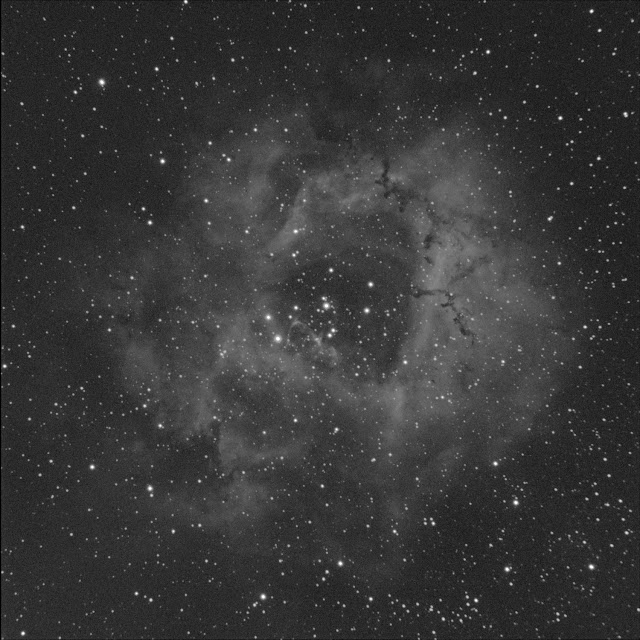Starting with balanced monochrome channel images, I used our Rosette nebula Ha, OIII and SII data to produce the following palettes.
The balanced mono channels
Ha:
OIII:
SII:
For comparison purposes we shall first show the Hubble palette and the Canada, France, Hawaii Telescope palettes.
The Hubble palette: SHO
The Canada, France, Hawaii Telescope palette: HOS
These two palettes use whole channel combinations as RGB images.
All of the palettes shown here also have gentle, selective colour processing to enhance to hues in the final palettes. Also all of the processing was done on starless images, where the stars were removed by the Gimp 2.10 plugin Starnet++.
There are however, palettes that use static factors for blending narrowband data
The 'Natural' palette
The ‘Natural’ palette is a narrowband color palette that uses a combination of Ha, OIII and SII filters to create a pseudo-natural color image. It was developed by Robert Gendler, an astrophotographer and physician.
The Natural palette uses the following formula for each color channel:
Red: 0.75 SII + 0.25 Ha
Green: OIII
Blue: 0.1 Ha + 0.9 OIII
The balanced monochrome narrowband images were blended in these proportions to produce the 'Natural' RGB channels
Natural palette image of the Rosette nebula
The ‘Gendler’ palette
The ‘Gendler’ palette is a narrowband color palette named for Robert Gendler, who developed it as a variation of his Natural palette.
The Gendler palette uses the following formula for each color channel:
Red: 0.8 SII + 0.2 Ha
Green: 0.6 OIII + 0.4 Ha
Blue: 0.4 OIII + 0.6 SII
Gendler palette image of the Rosette nebula
I think that this is a pleasing palette that compares favourably with the Hubble palette.
There is a bicolour palette that is commonly used that makes use of the full Ha and OIII narrowband images. This is the HOO palette.
HOO palette image of the Rosette nebula
I produced a palette inspired by the HOO palette but using blended data from the Ha & SII channels and OIII balanced monochrome narrowband images. I call this the 'SHOO' palette.
The SHOO palette uses the following formula for each color channel:
Red: 0.5 SII + 0.5 Ha
Green: OIII
Blue: OIII
SHOO palette image of the Rosette nebula
It is clear that there is scope for the experimental development of palettes and that the final appearance of each palette depends on a number of factors such as the initial balancing of the channels and the degree, if any, of selective colour enhancement.
Although this article is about static factor channel blending, it is also possible to blend channels using dynamic narrowband combinations. An example of this methodology is the FORAAX palette. The software engineer and astrophotographer Paul Hancock who goes by the Internet identity of Paulyman Astro wrote a script for PixInsight that automates the process of creating narrowband images in the Foraxx palette. The Foraxx Palette uses dynamic factors for each pixel, instead of static factors for the whole image. This kind of dynamic pixel math can be done in other software such as Siril or Image Magick and the same results achieved.








